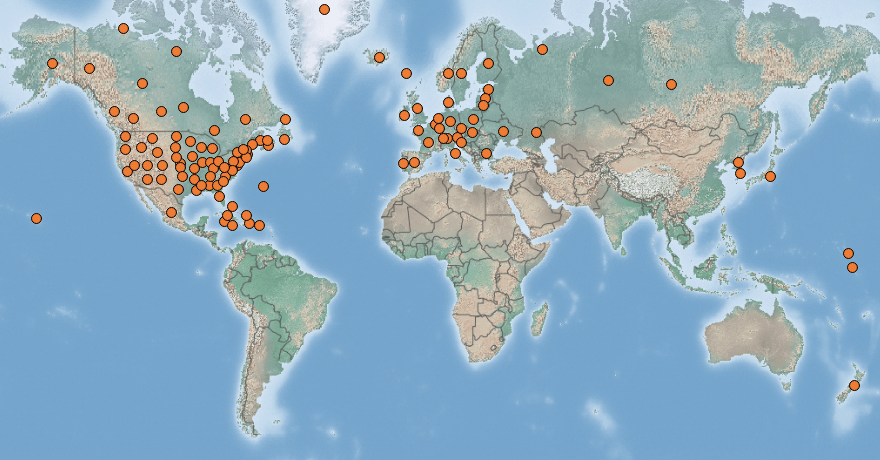 |
Canada goose | Status LU: established. 1st record: 1980. |
 |
Kanadagäns1 | Status Eur.: established. |
 |
Bernache du Canada | RA: ISEIA: B3, Watch List. Harmonia+: n/a. |
 |
Kanadagans | Wikipedia:     | Wikispecies: | Wikispecies:  | CABI | CABI |
 |
Grote Canadese gans | Back to the list of vertebrates |
Contents
Report the species
→ Report Branta canadensis to the National Museum of Natural History.
Brief description
 Branta canadensis (Linnaeus, 1758) most often breed along small meso- to eutrophic ponds near open habitats with short grass. They are especially common in man-made habitats (parks, urban and agricultural areas) but are also known to colonise natural wetlands and coastal areas. The Canada goose is primarily a grazer and feeds mainly on grasses and aquatic plants. The species often exhibits direct aggression to other bird species through strong territorial behavior. High goose densities damage wetland habitats by overgrazing, fouling and trampling (Anselin et al. 2012).
Branta canadensis (Linnaeus, 1758) most often breed along small meso- to eutrophic ponds near open habitats with short grass. They are especially common in man-made habitats (parks, urban and agricultural areas) but are also known to colonise natural wetlands and coastal areas. The Canada goose is primarily a grazer and feeds mainly on grasses and aquatic plants. The species often exhibits direct aggression to other bird species through strong territorial behavior. High goose densities damage wetland habitats by overgrazing, fouling and trampling (Anselin et al. 2012).
Status and distribution in Luxembourg
Records of Branta canadensis L. in Luxembourg. Data source: Recorder-Lux, iNaturalist & GBIF, 2025-12-17.
Branta canadensis (Linnaeus, 1758) was first reported by Eugène Conrad on 19th April 1980 in the area of Stolzembourg, municipality of Putscheid (Konter et al. 2009). The first documented breeding in Luxembourg dates from 2002 from the nature conservation reserve Cornely’s Millen, near Troisvierges in the far north of the country (Bastian 2016: 6). The first successful breeding attempt was documented in 2002. Meanwhile the species breeds regularly in Luxembourg with some 10 to 15 breeding couples, especially on the Moselle river and in the Oesling area (Lorgé & Melchior 2015). Today the Canada goose is less widespread in Luxembourg than the Egyptian goose. A recent survey estimates the actual breeding population of the Canada goose to a total of 18 breeding couples (Bastian 2016: 13). Problems caused by Canada geese were reported in 2016 by several local authorities to the Department of Environment of MDDI, concerning several playgrounds, promenades and open air swimming pools in the Moselle area, and also from problems in a vineyard in the Schengen area.
An identification sheet of the species has been published by the MECDD in French and German.
Risk assessment
ISEIA protocol
B3 (3+3+2+2) = Watch List. Assessment update on 15 May 2018 by Patrick Lorgé, Christian Ries & Manou Pfeiffenscheider. First assessment: A1 (3+3+3+3) = Black List (Ries et al. 2014: 199). The adverse impacts on native species and ecosystem functions were overestimated by the first assessment.
Harmonia+ protocol
Not assessed yet.
Worldwide distribution
Fact sheet
PDF fact sheet of the Nature and Forestry Administration: FR | DE
Bibliography
- Anders, C., 2017. Erfassung der Bestände von Kanadagans (Branta canadensis) und Nilgans (Alopochen aegyptiaca) im Jahr 2016 im Großherzogtum Luxemburg. Regulus Wissenschaftliche Berichte 32: 12-19.
- Anselin, A., E. Branquart, K. Devos, J.-Y. Paquet, D. Strubbe, D. Vangeluwe & A. Weiserbs, 2012. Harmonia database: Branta canadensis (Linnaeus, 1758). Harmonia version 1.2, Belgian Forum on Invasive Species. URL: http://ias.biodiversity.be [accessed 2020-04-22]
- Bastian, M., 2016. Kanadagans (Branta canadensis) und Nilgans (Alopochen aegyptiaca) in Luxemburg. Bericht zur Erfassung der Kanadagans und der Nilgans im Jahr 2016 zur Untersuchung der Verbreitung, der Bestände sowie der Bestandsentwicklung im Großherzogtum Luxemburg. Centrale ornithologique Luxembourg, natur&ëmwelt a.s.b.l., Kockelscheuer. 21 p.
- CABI, 2019. Branta canadensis (Linnaeus, 1758). In: Invasive Species Compendium. Wallingford, UK: CAB International. URL: www.cabi.org/isc [accessed 2020-04-22]
- Konter, A., 2015. Die weitere Entwicklung der Wasservogelwelt an der Sauer unterhalb von Steinheim in den Jahren 2012-2014. Regulus Wissenschaftliche Berichte 30: 1-34.
- Konter, A., 2016. Die Kanadagans Branta canadensis auf der Sauer unterhalb von Steinheim: Aufkommen, aggressives Verhalten und Bruten nach der Renaturierung des Gebiets. Regulus Wissenschaftliche Berichte 31: 23-27.
- Konter, A., 2021. Beobachtung einer Auseinandersetzung zwischen zwei Höckerschwänen Cygnus olor und einer Kanadagansfamilie Branta canadensis. Regulus Wissenschaftliche Berichte 36: 75-79.
- Konter, A. & P. Lorgé, 2009. Vorkommen und Brut von Kanada- Branta canadensis (Linné 1758) und Nilgans Alopochen aegyptiacus (Linné 1766) in Luxemburg. Regulus wissenschaftliche Berichte 24: 49–54.
- Lorgé, P. & E. Melchior, 2015. Vögel Luxemburgs, natur&emwelt, ISBN: 978-2-919920-01-3, 9. Ausgabe, 273 pp.
- MNHNL, iNaturalist & GBIF, 2020. Branta canadensis (Linnaeus, 1758) in MNHNL-mdata, online portal combining species observation from Recorder-Lux, iNaturalist and GBIF. National Museum of Natural History, Luxembourg. URL: https://mdata.mnhn.lu [accessed 2020-04-22]
- Ries, C., M. Pfeiffenschneider, Engel, E., J.-C. Heidt & M. Lauff, 2014. Environmental impact assessment and black, watch and alert list classification after the ISEIA Protocol of vertebrates in Luxembourg. Bull. Soc. Nat. luxemb. 115: 195-201. [PDF 247 KB]
- Weiss, J., 2015. Liste der Luxemburger Vogelnamen. Regulus Wissenschaftliche Berichte 29 (2014): 69-79. [PDF 1.1 MB]
Suggested citation of this webpage
Ries, C. & M. Pfeiffenschneider (Eds.), 2025. Branta canadensis (Linnaeus, 1758). In: neobiota.lu - Invasive Alien Species in Luxembourg. National Museum of Natural History, Luxembourg. URL: https://neobiota.lu/branta-canadensis/ [Accessed 2025-12-17].
Page content last updated on 2023-08-17. Last proofread by Caroline Grounds on 2019-11-27.
- Cf. Weiss 2015: 73.[↩]


